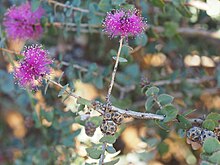| Melaleuca cordata | |
|---|---|

| |
| Scientific classification | |
| Kingdom: | Plantae |
| Clade: | Tracheophytes |
| Clade: | Angiosperms |
| Clade: | Eudicots |
| Clade: | Rosids |
| Order: | Myrtales |
| Family: | Myrtaceae |
| Genus: | Melaleuca |
| Species: | M. cordata |
| Binomial name | |
| Melaleuca cordata Turcz. | |
| Synonyms | |
| |
Melaleuca cordata is a plant in the myrtle family Myrtaceae, and is endemic to the south-west of Western Australia. It is a small shrub with erect branches, heart-shaped leaves and clusters of pinkish-red to purple flowers over an extended period.
Description
Melaleuca cordata is an erect, bushy shrub which grows to a height of between 0.3 and 3 m (1 and 10 ft) with dark grey, fibrous bark. Its leaves are egg-shaped to heart-shaped, between 7.5 and 30 mm (0.3 and 1 in) long and wide with a very short, or no stalk. They are glabrous when mature, spirally arranged around the stem with 5 to 9 veins and have a pointed end.
The flowers are deep pink to purplish-red, forming roughly spherical heads of flowers, thickly clustered on or near the ends of the stems. The flowers appear for extended periods from late spring to mid-summer. The fruit which follow flowering are woody capsules about 4 mm (0.2 in) in diameter, arranged in roughly spherical clusters.


Taxonomy and naming
Melaleuca cordata was first formally described in 1852 by the Russian botanist, Nikolai Turczaninow. The Latin specific epithet (cordata) means "cordate" or "heart-shaped", referring to the shape of the leaves.
Distribution and habitat
This melaleuca is endemic to the south-west of Western Australia from the Geraldton-Mullewa districts south to the Lake Grace-Lake King area and east to Coolgardie. It occurs in the Coolgardie, Avon Wheatbelt, Geraldton Sandplains, Mallee and Warren biogeographic regions. It grows in a range of habitats including sandy, often gravelly soils on sandplains.
Conservation status
Melaleuca cordata is listed as "not threatened" by the Government of Western Australia Department of Parks and Wildlife.
Use in horticulture
Its unusual foliage and long flowering period may make M. cordata an attractive and useful garden plant. It grows in a wide range of soils in temperate areas with low winter rainfall.
References
- ^ "Melaleuca cordata". Plants of the World Online. Retrieved 27 August 2021.
- ^ Brophy, Joseph J.; Craven, Lyndley A.; Doran, John C. (2013). Melaleucas : their botany, essential oils and uses. Canberra: Australian Centre for International Agricultural Research. p. 131. ISBN 9781922137517.
- ^ Holliday, Ivan (2004). Melaleucas : a field and garden guide (2nd ed.). Frenchs Forest, N.S.W.: Reed New Holland Publishers. pp. 66–67. ISBN 1876334983.
- "Melaleuca cordata". APNI. Retrieved 1 March 2015.
- Francis Aubie Sharr (2019). Western Australian Plant Names and their Meanings. Kardinya, Western Australia: Four Gables Press. p. 170. ISBN 9780958034180.
- Short, Emma; George, Alex (2013). A Primer of Botanical Latin with Vocabulary. Cambridge, U.K.: Cambridge University Press. p. 148. ISBN 9781107693753.
- William T. Stearn (1992). Botanical Latin. History, grammar, syntax, terminology and vocabulary (4th ed.). Portland, Oregon: Timber Press. p. 391.
- ^ "Melaleuca cordata". FloraBase. Retrieved 30 April 2015.
- Paczkowska, Grazyna; Chapman, Alex R. (2000). The Western Australian flora : a descriptive catalogue. Perth: Wildflower Society of Western Australia. p. 392. ISBN 0646402439.
| Taxon identifiers | |
|---|---|
| Melaleuca cordata | |